Picking the right colors for your Victorian home can feel overwhelming.
The many trim details, ornate features, and layered elements of your house require careful planning to make it look its best.
Are you ready to paint your Victorian home but feeling unsure about color choices and methods?
From 1837 to 1901, Victorian buildings stand out for their special details, patterns, and rich color mixes.
These homes tell stories through their paint – but getting those stories right takes know-how.
In this guide, you’ll learn:
- Time-tested color pairings that work for Victorian homes
- Ways to fix common painting problems
- How to pick colors that match your home’s style
With over 25 years of experience restoring Victorian homes, I’ve tested what works.
I’ll share practical tips to help you paint your Victorian house with confidence while saving time and money.
Classic Victorian Exterior Paint Color Ideas
Victorian homes are unique, aren’t they?
Their ornate trims and bold architectural details beg for just the right colors. I’ve got 19 paint color ideas to help you make your home stand out.
Some are timeless classics, while others add a modern twist.
Let’s explore these color options together:
1. Sage Green with Cream Trim
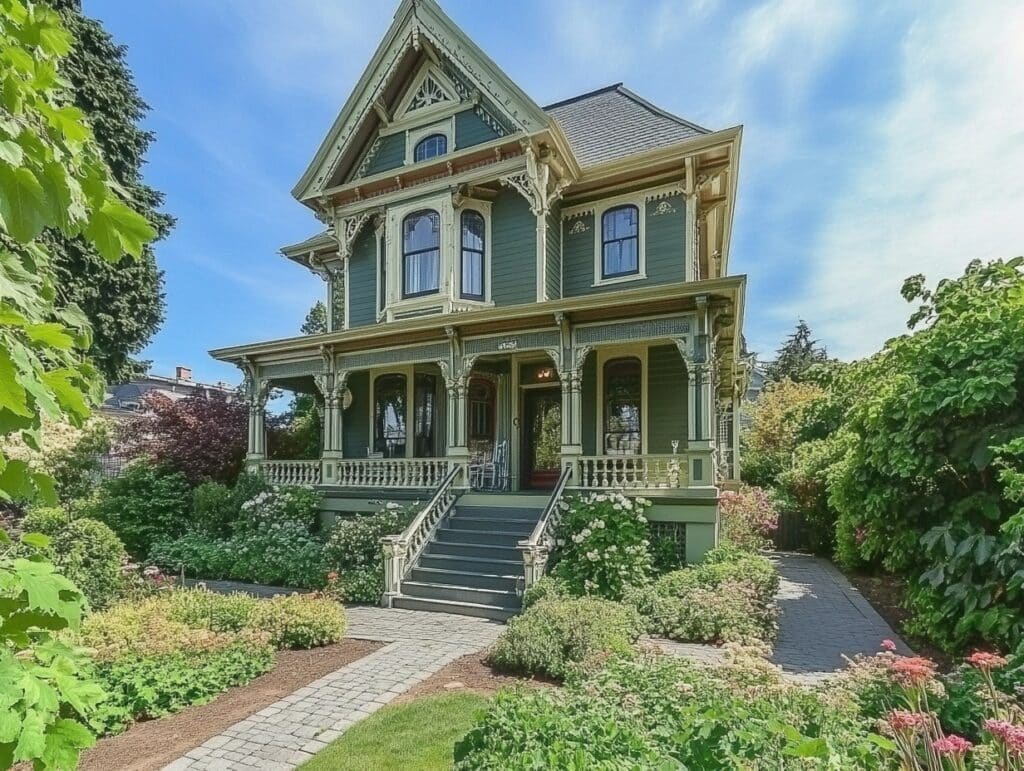
Sage green provides a soft, earthy base that blends beautifully with the natural surroundings.
Pairing it with cream trim highlights architectural details, such as window frames or columns.
This combination is perfect for Victorian homes with intricate woodwork.
The cream accentuates every curve and edge, while the green adds an understated elegance.
2. Dusty Blue with White Accents
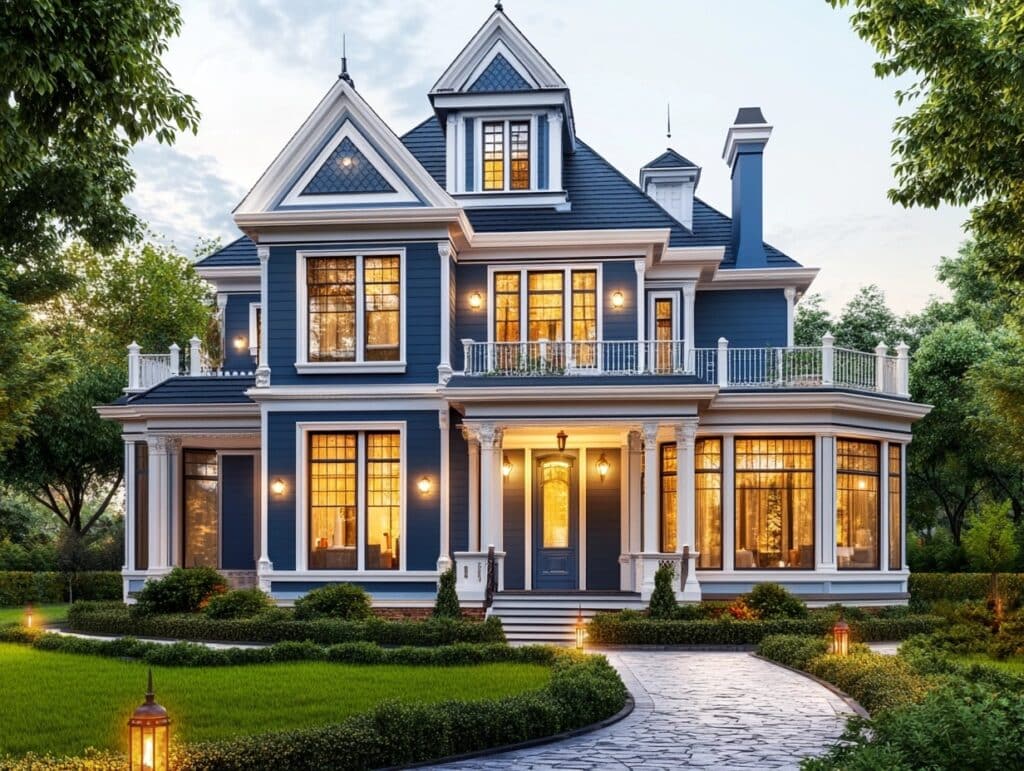
Dusty blue is a timeless shade that evokes calm and stability.
It works well with crisp white accents, creating a clean and refreshing look.
This pairing is ideal for showcasing the symmetry of Victorian homes while keeping the overall aesthetic light and airy.
It’s especially striking on homes with wraparound porches or large bay windows.
3. Deep Burgundy with Gold Details

Deep burgundy offers a rich and luxurious feel, while gold accents add a touch of elegance.
This combination is perfect for homes with tall gables or turrets, as the gold can be used to outline intricate patterns.
It’s a bold choice that captures the drama and sophistication of the Victorian era.
4. Olive Green with Deep Red Trim
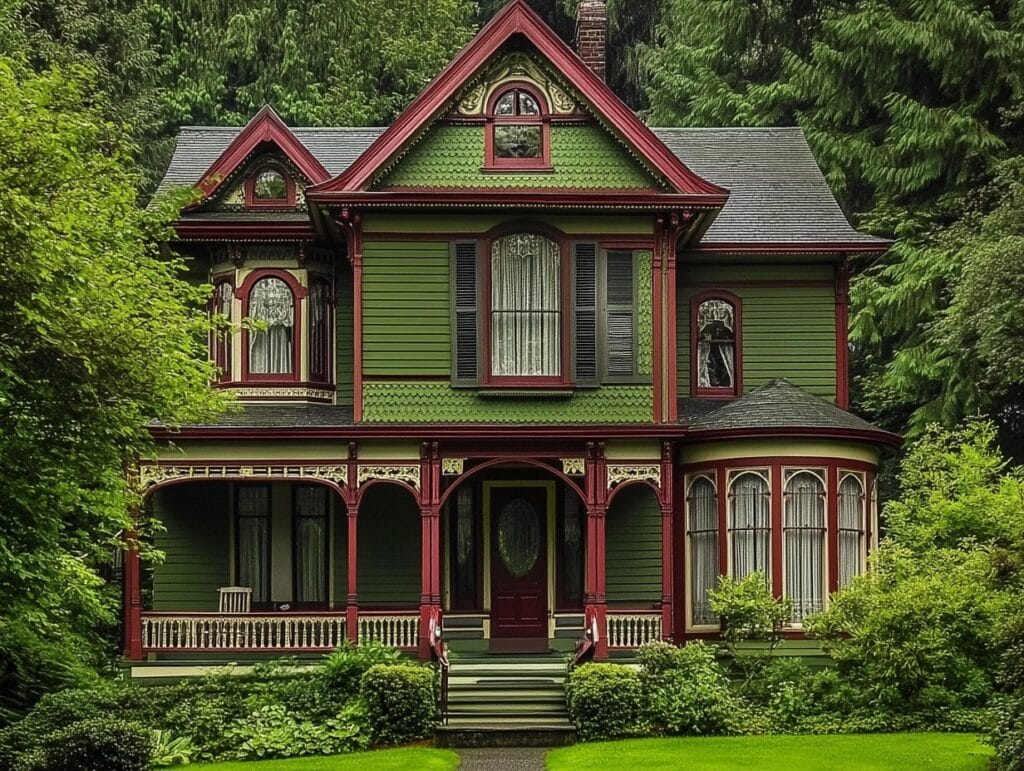
Olive green is a versatile choice that exudes warmth and beauty.
Pair it with deep red trim to create a classic yet vibrant contrast.
The red works beautifully on shutters, doors, and railings, while the olive base keeps the overall look grounded.
It’s an excellent choice for homes in lush, green landscapes.
5. Charcoal Gray with Ivory Highlights
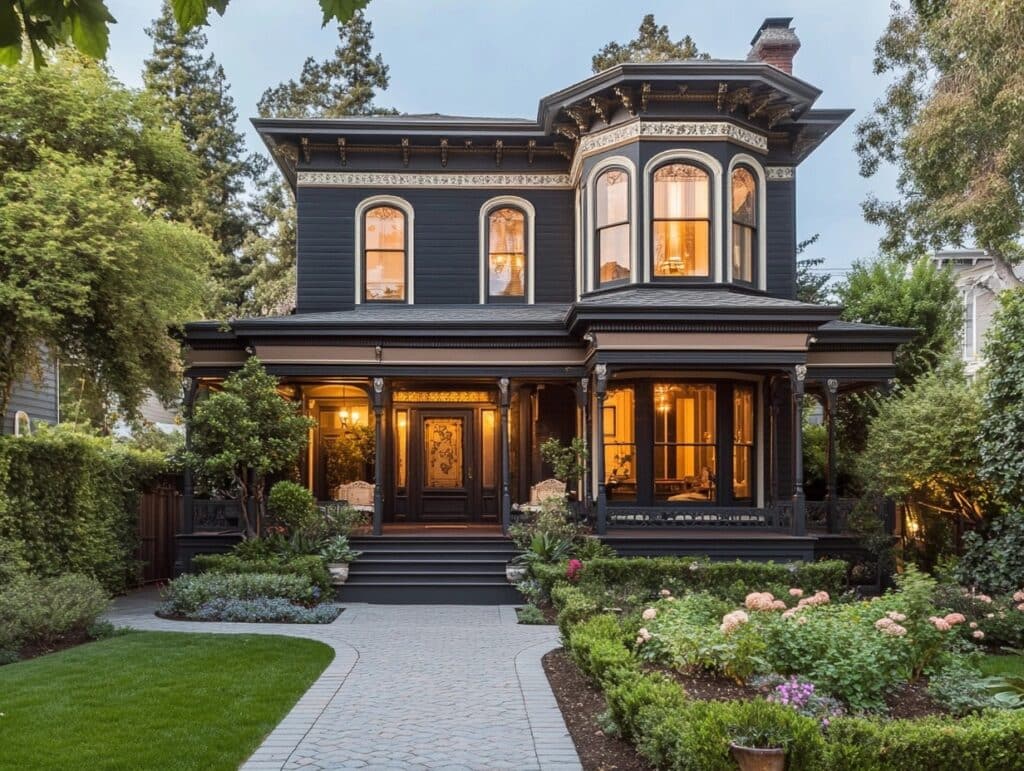
Charcoal gray is sleek and modern, but when paired with ivory highlights, it takes on a more traditional Victorian feel.
Ivory can be used to break up the dark gray on ornate trims, eaves, and even porch spindles.
This combination works especially well for those who prefer a subtle yet sophisticated palette.
6. Warm Taupe with Dark Green Trim
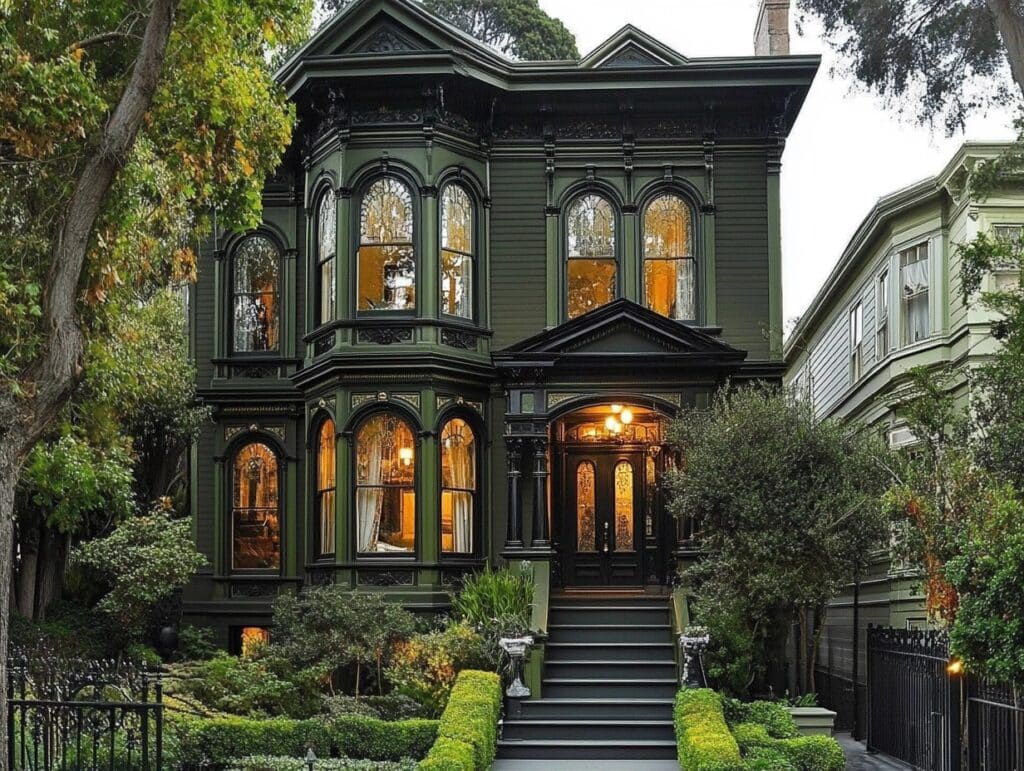
Warm taupe is an understated neutral that works beautifully as a base color.
Adding dark green trim gives it depth and richness.
This combination is perfect for showcasing detailed woodwork.
The green draws attention to decorative elements, while the taupe provides a cozy, inviting backdrop.
7. Navy Blue with Cream Accents
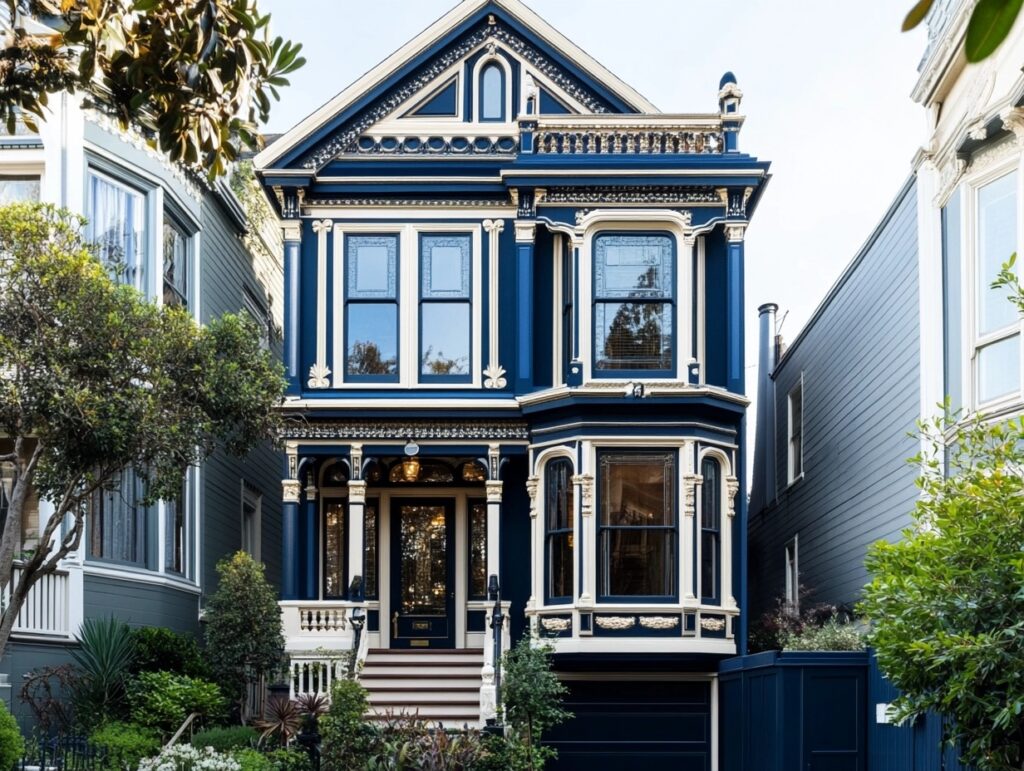
Navy blue is a bold, classic color that pairs beautifully with cream accents.
The cream softens the dark base, creating a balance that highlights intricate Victorian designs.
Use the cream on trims, railings, and window frames to add a touch of brightness to the deep blue.
8. Butter Yellow with White Trim
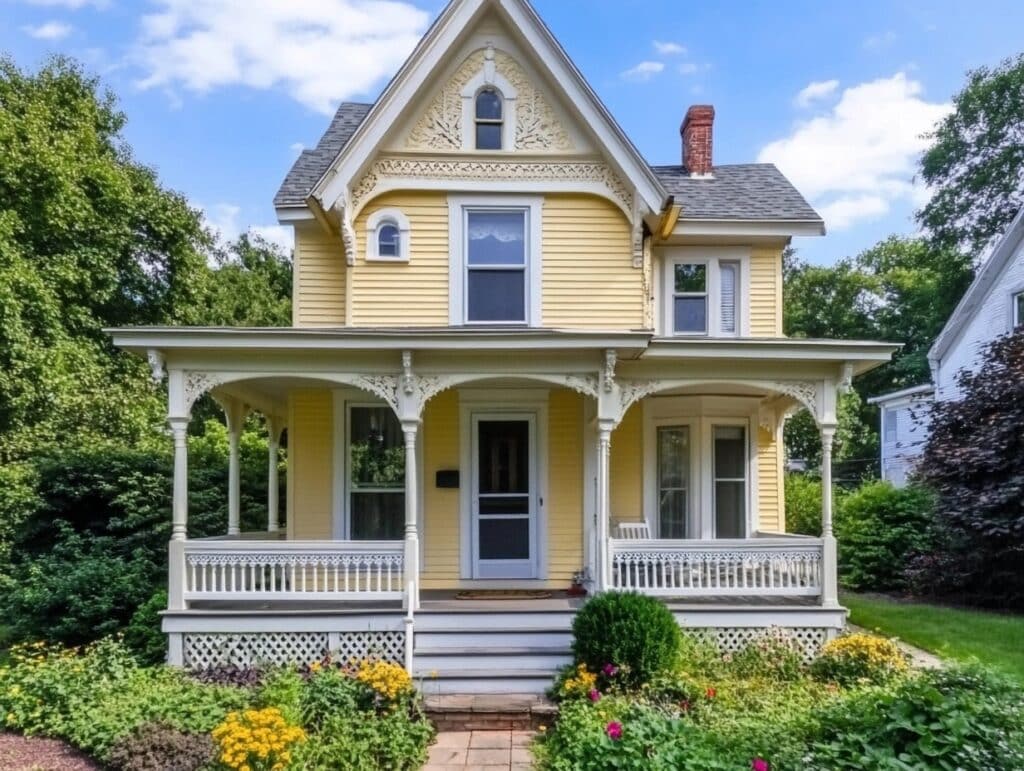
Butter yellow is a cheerful and warm choice, especially for smaller Victorian homes.
The white trim adds a crisp contrast that makes every architectural detail pop.
This combination is ideal for sunny locations, as the yellow reflects light beautifully, giving your home a bright and inviting look.
9. Terracotta with Pale Sage Accents
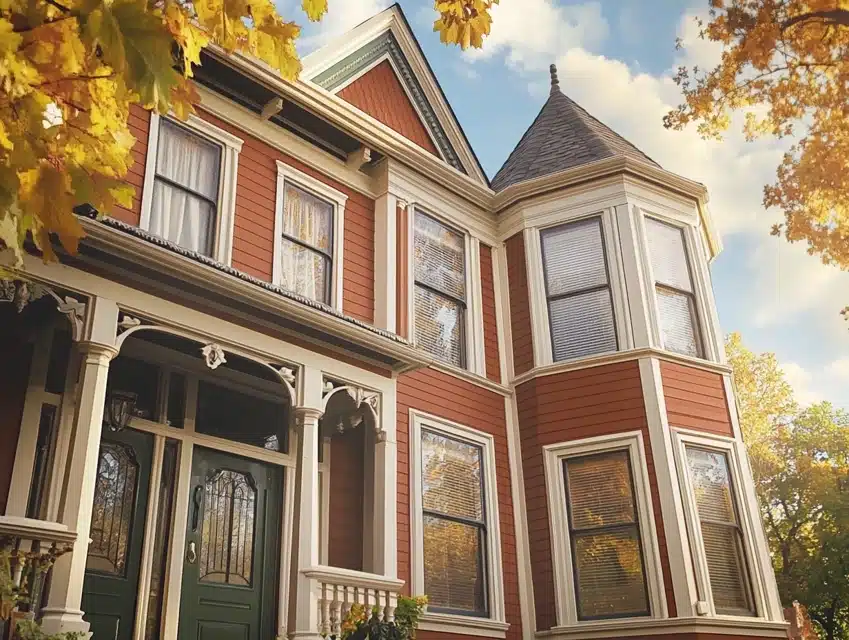
Terracotta is a warm and earthy shade that looks stunning on Victorian homes.
Pairing it with pale sage accents softens the look while keeping it grounded.
The sage works well on doors, shutters, or decorative trim, creating a harmonious yet dynamic effect for fall-inspired settings.
10. Plum with Gold and Ivory Highlights
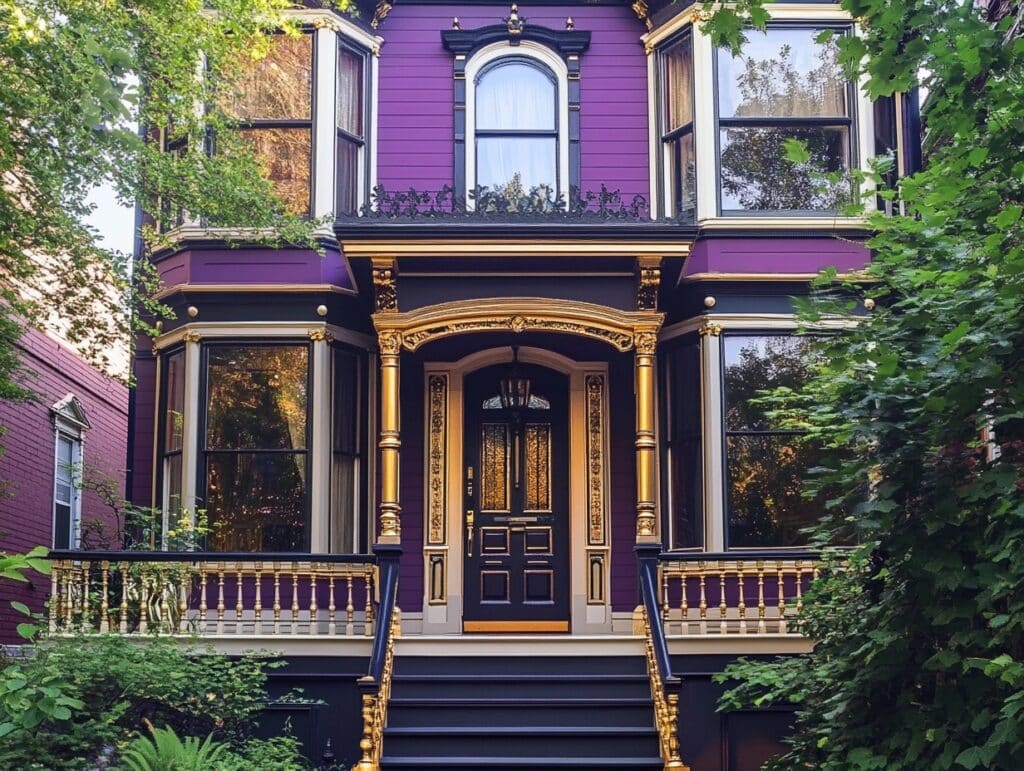
Plum is a rich, dramatic color that brings a regal feel to your home.
Adding gold and ivory highlights enhances its sophistication and makes intricate patterns stand out.
Use the gold sparingly for accents on railings or doors, while ivory works on trims and spindles to provide balance.
11. Brick Red with Black Trim

Brick red is a bold, traditional choice that reflects Victorian heritage.
Pairing it with black trim adds a striking contrast, creating a bold and memorable facade.
The black works particularly well on shutters, doors, and railings, adding depth and drama to the red base.
12. Soft Lavender with Gray Accents
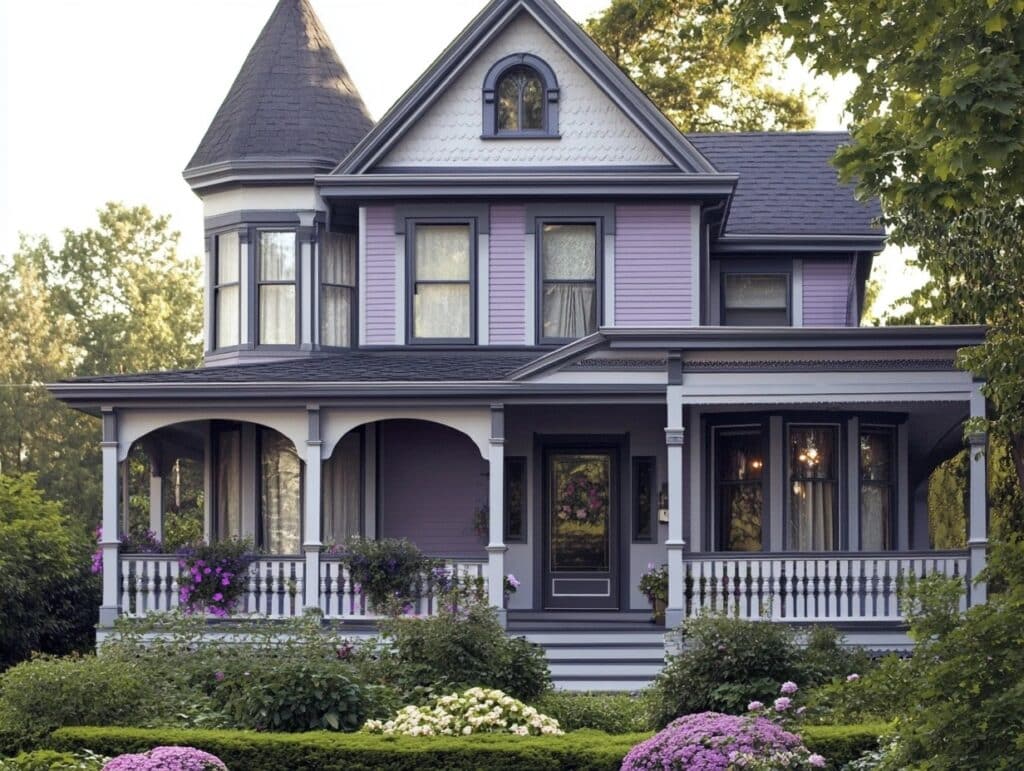
Soft lavender is a less common but equally beautiful choice for Victorian homes.
Pair it with gray accents to tone down the sweetness and create a balanced, elegant look.
The gray can be used on trims, window frames, and railings to add sophistication without overpowering the lavender base.
13. Black Forest Green with White Trim
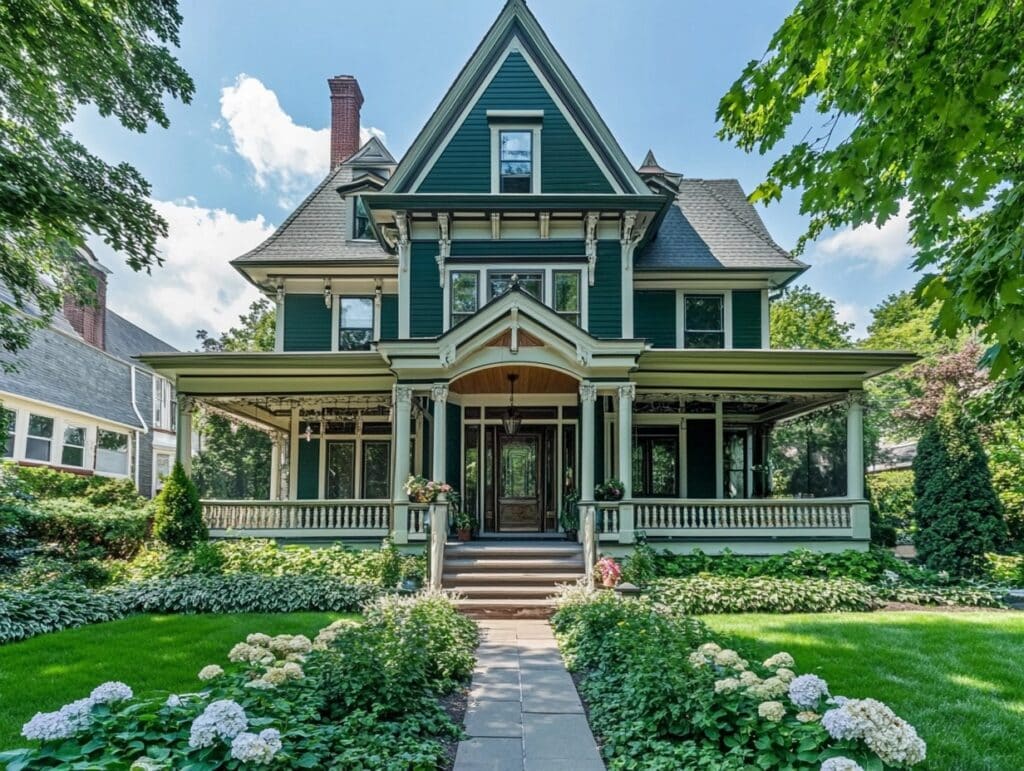
Black forest green is a deep, moody shade that exudes elegance.
Pair it with white trim to create a clean and striking contrast.
The white highlights architectural features like columns and decorative woodwork, making the green appear richer and more dramatic.
14. Copper with Beige Highlights
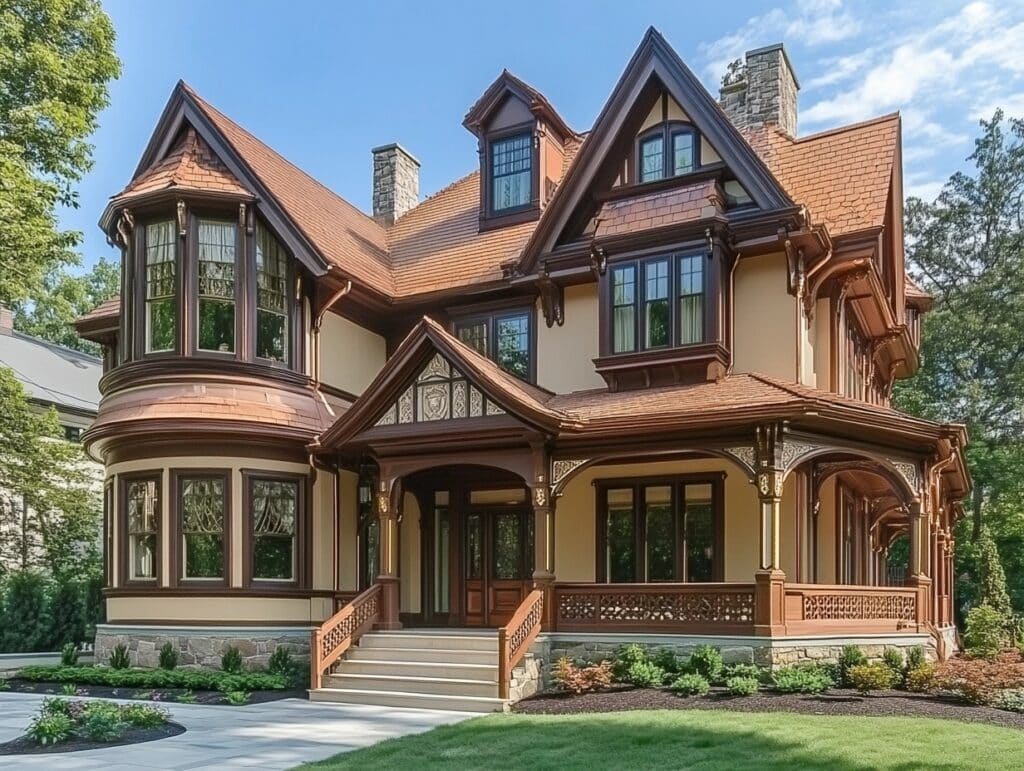
Copper is a bold, metallic color that stands out beautifully on Victorian exteriors.
Adding beige highlights softens the overall look while maintaining a warm tone.
Use the beige on trims and accents to create balance and enhance the metallic sheen of the copper base.
15. Eggplant with Pale Yellow Accents
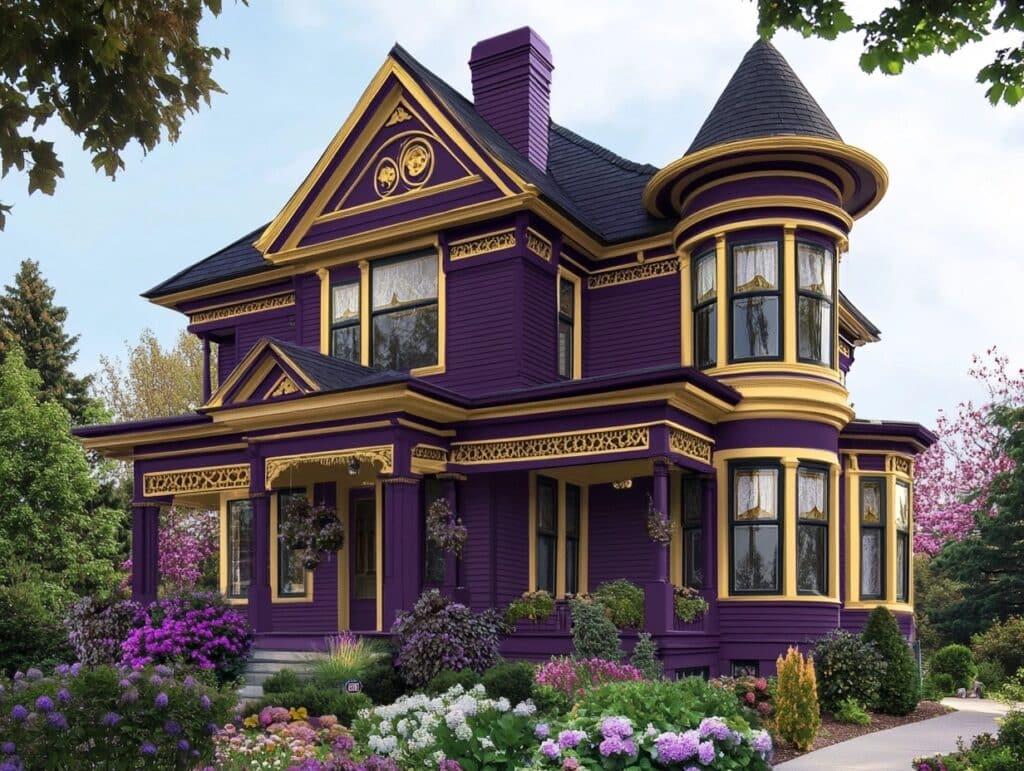
Eggplant is a bold, daring choice for Victorian homes.
Pairing it with pale yellow accents creates a vibrant yet balanced palette.
The yellow works well on trims and decorative details, adding brightness and contrast to the dark, rich base color.
16. Powder Blue with Gold Details
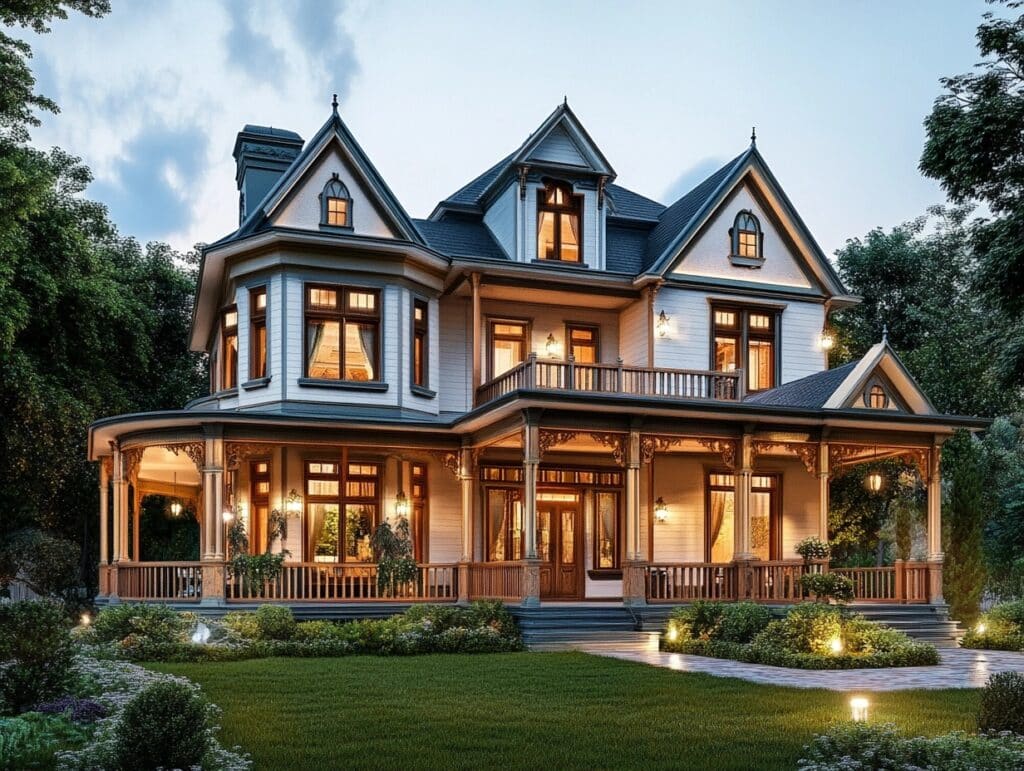
Powder blue is a light, calming shade that looks stunning on Victorian homes.
Adding gold details, especially on trims and railings, gives it a luxurious touch.
This combination works well for those who want a soft yet refined look.
17. Ivory with Deep Teal Trim
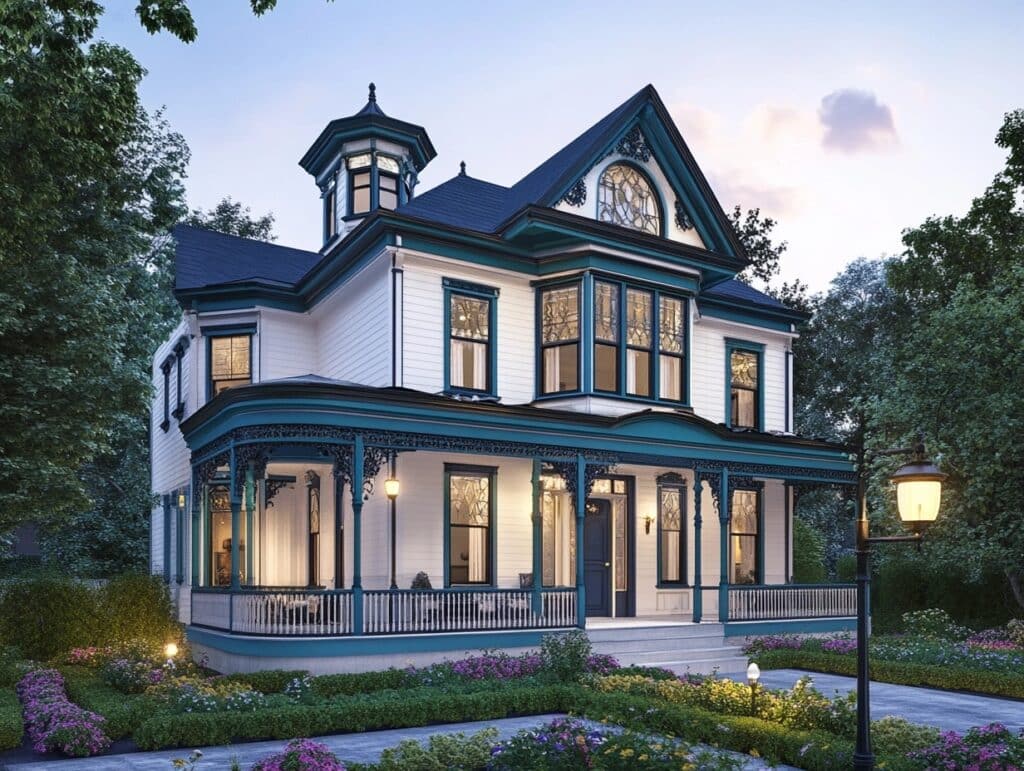
Ivory is a timeless neutral that makes Victorian homes look fresh and classic.
Deep teal trim adds a pop of color, creating a sophisticated and modern contrast.
This combination is ideal for homes with large porches or intricate woodwork.
18. Chocolate Brown with Cream Accents
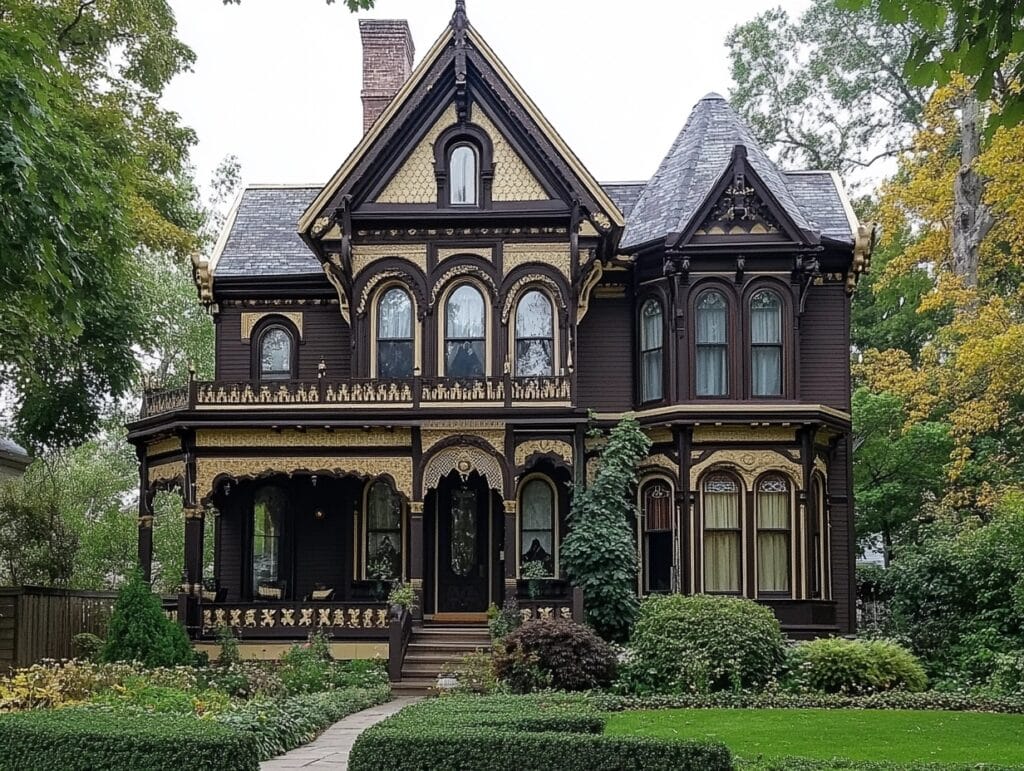
Chocolate brown is a cozy and inviting choice for Victorian homes.
Pairing it with cream accents adds brightness and highlights decorative details.
Use the cream on trims, window frames, and eaves to create a balanced and welcoming look.
19. Hunter Green with Burgundy Details
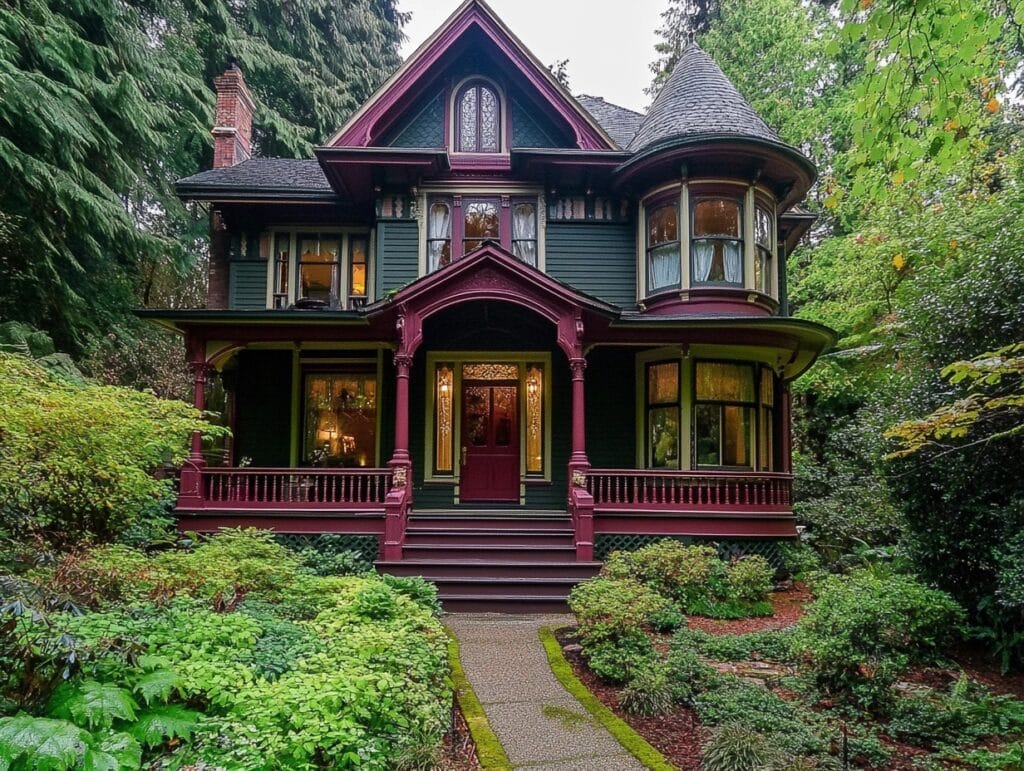
Hunter green is a classic Victorian shade that pairs beautifully with burgundy details.
The burgundy works well on doors, shutters, and railings, creating a warm and harmonious contrast.
This combination is perfect for homes in wooded areas or lush landscapes.
DIY Tips for Painting Victorian Exteriors
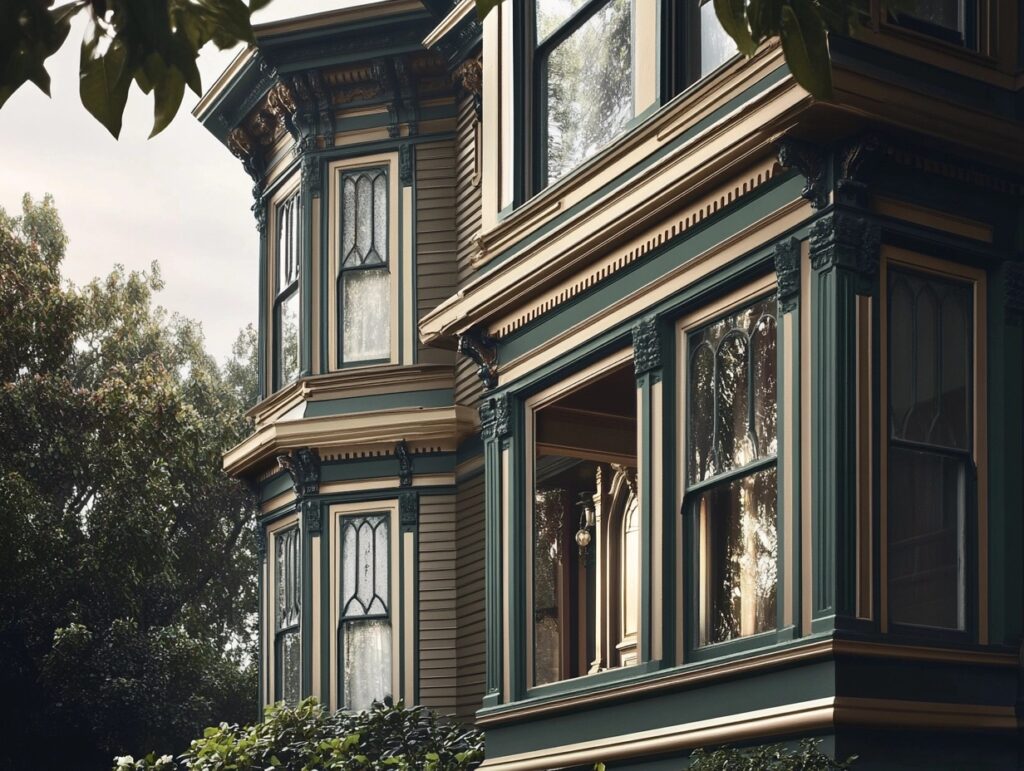
Painting a Victorian home can feel like a big task, but it’s manageable with the right steps.
Let me guide you through it so you can achieve a polished, professional look without breaking the bank.
I’ll show you steps that work even if you’ve never painted a house before.
Picking Your Tools
Here’s what you’ll need:
- 4-inch brush for big areas
- 2-inch brush for trim
- Paint rollers and poles
- Drop cloths
- Safety glasses
- Face mask
- Sturdy ladder
Preparation Steps
1. Clean and Repair the Exterior
Before painting, make sure the surface is clean and smooth.
- Wash the walls to remove dirt, mold, or old paint flakes.
- Fix any cracks or holes with filler.
- Sand rough areas for an even surface.
A clean and repaired surface ensures your paint sticks better and lasts longer.
2. Choose the Right Primer and Tools
A good primer is essential, especially for older homes with worn surfaces.
- Use a stain-blocking primer for wood to prevent bleed-through.
- Pick quality brushes and rollers designed for exterior surfaces.
Investing in the right tools will save you time and effort later.
Techniques to Follow
1. Layering Colors for Intricate Victorian Details
Victorian homes often have trims, moldings, and decorative panels. These need different colors to stand out.
- Start with the base color and let it dry completely.
- Then, move to the trim and accents, working carefully in sections.
This layering technique helps you get clean, sharp lines.
2. Use Painter’s Tape for Sharp Trim Lines
Painter’s tape is your best friend here.
- Apply it to edges where different colors meet, like between trims and walls.
- Press it firmly to avoid paint seeping under.
Peel it off slowly while the paint is still slightly wet for a perfect finish.
Budget-Friendly Advice
1. How to Save on Paint Without Compromising Quality
You don’t need to splurge on expensive brands for great results.
- Look for mid-range paints that offer durability and weather resistance.
- Check for sales or leftover paints from local hardware stores.
A little research can go a long way to stretch your budget.
2. DIY Alternatives to Professional Painting
You don’t need to hire a painter if you’re willing to do the work.
- Borrow tools like ladders and sprayers from friends or rental shops.
- Watch online tutorials for techniques and inspiration.
Taking the DIY route saves you money and gives you a sense of accomplishment.
How Many Colors Should a Victorian House Have?
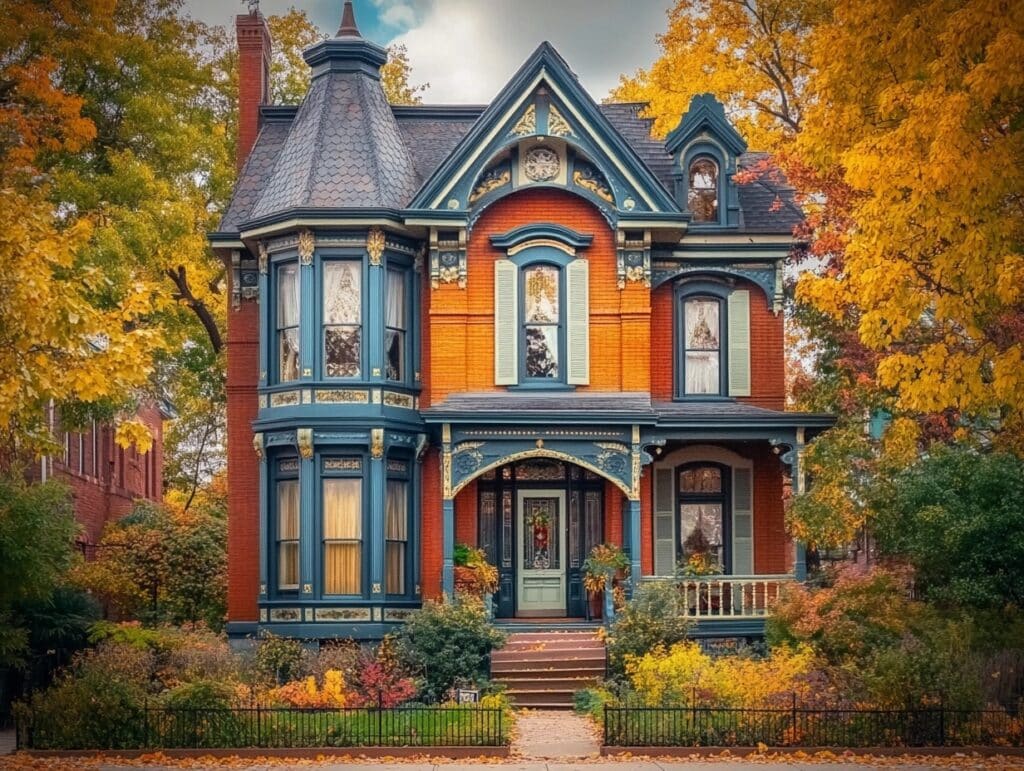
Painting a Victorian house can feel overwhelming when it comes to choosing colors.
How many do you really need?
Let’s break it down so you can make the right choice for your home.
Understanding Victorian Color Schemes
1. The Traditional “Three-Color Rule”
Victorian homes often followed a three-color scheme:
- Base color: The main body of the house.
- Trim color: Frames, windows, doors, and other details.
- Accent color: Highlights smaller decorative elements like spindles or brackets.
This simple approach creates balance and emphasizes the home’s architectural features.
2. Modern Interpretations
Today, you can go beyond three colors if you want more variety.
- Use up to five complementary shades to highlight intricate designs.
- Add subtle differences in tones for depth, such as light and dark shades of the same color.
More colors give you freedom, but you can feel busy if you do not do it carefully.
When to Keep It Simple vs. Elaborate
1. Small Homes: Fewer Colors Work Best
If your Victorian home is on the smaller side, stick to three colors.
- Too many shades can make it feel cluttered.
- Simpler schemes keep the look clean and cohesive.
2. Large Homes: More Colors Add Charm
Bigger homes or those with intricate details can handle four or five colors.
- Use the extra shades to highlight decorative trim, columns, or gables.
- A wider palette can make ornate features pop without overwhelming the overall look.
My Best Advice
Start with three colors.
Paint a small test area. If something feels missing, add another color. You can always add more, but fixing too many colors is hard.
Remember: The number of colors you pick now will affect how much work you do later. Each color needs its own painting time and touch-ups over the years.
Want to make a smart choice?
Look at other Victorian houses in your area. See what works on homes like yours.
Things to Consider When Choosing Exterior Paint Colors
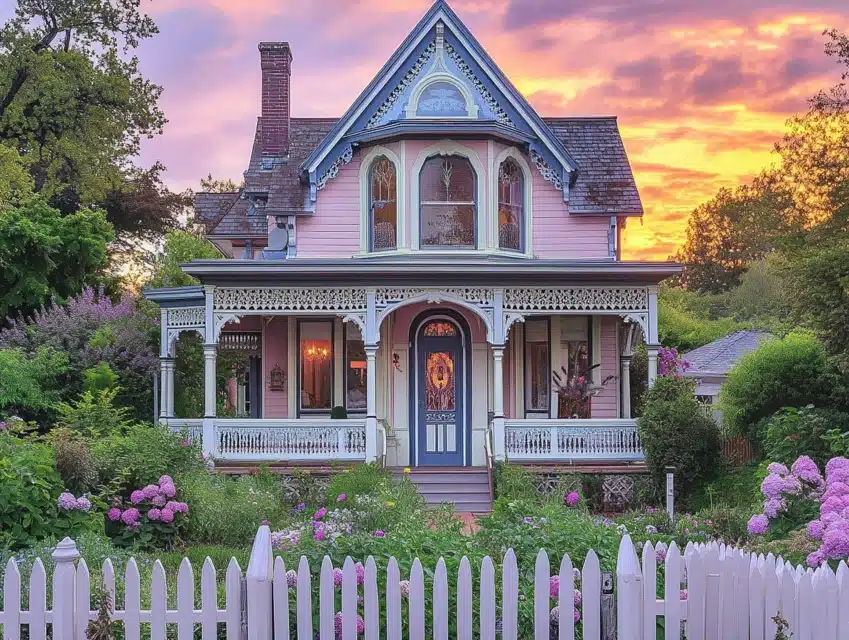
Choosing the perfect exterior paint colors for your Victorian house takes more than picking a shade you like.
It would help if you thought about several factors to get it right.
Let’s walk through them.
Architectural Features
Your home’s design deserves attention.
- Highlight trims: Use contrasting colors to emphasize intricate trims and moldings.
- Accentuate spindles: Small, decorative details pop with bold or bright hues.
- Don’t forget ornate elements: Features like gables or brackets stand out with an accent color.
Look closely at your home. Every detail can shine with the right shade.
Environmental Factors
Where your house sits matters, too.
- Weather conditions: In sunny areas, lighter colors reflect heat and last longer. In damp climates, dirt-resistant shades can help.
- Neighborhood compatibility: Does your house blend in or stand out? Think about nearby homes and landscapes.
Choose colors that suit your surroundings while staying true to your vision.
Personal Preferences
This is your home, so your taste matters.
- If you love historical authenticity, stick to traditional Victorian palettes.
- Do you prefer a modern twist? Add contemporary colors while keeping some classic tones.
Find a balance between what you love and what fits the style of your home.
Paint Quality
Not all paints are created equal.
- Go for durable, weather-resistant options made for exteriors.
- Look for brands that offer UV protection, mold resistance, and long-lasting finishes.
Spending a bit more on quality paint saves time and money in the long run.
Common Challenges and How to Overcome Them
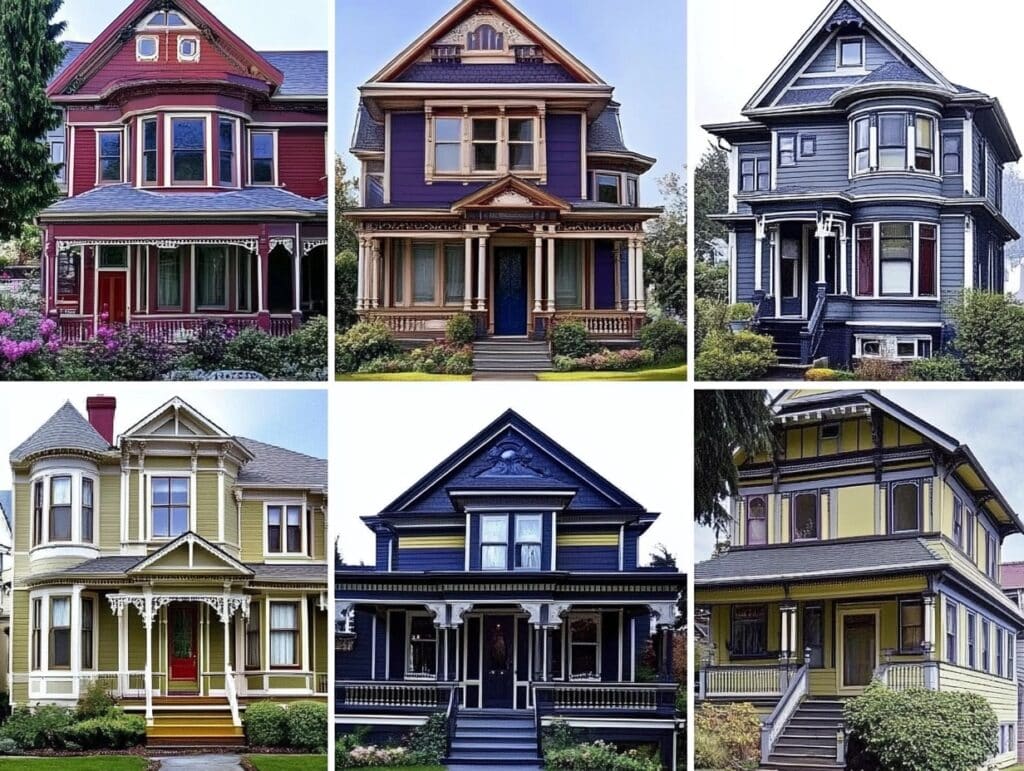
Painting a Victorian home isn’t always smooth sailing.
You’ll likely face a few challenges, but don’t worry—I’ve got solutions to help you handle them.
Challenge 1: Peeling or Cracking Paint
This happens when surfaces aren’t properly prepped.
- Solution 1: Scrape off loose paint and sand the surface smooth.
- Solution 2: Use a high-quality primer to seal the surface and ensure the new paint adheres well.
A little extra effort at the start can save you from peeling headaches later.
Challenge 2: Choosing the Right Colors
It’s hard to know if a color will look good until it’s on your house.
- Solution 1: Use digital tools to visualize how colors will look in your home.
- Solution 2: Test small swatches in different areas to see how they look in natural light.
Take your time. Testing beats regrets.
Challenge 3: Painting Intricate Details
Victorian homes have lots of small, ornate features. These can be tricky to paint.
- Solution 1: Invest in fine brushes designed for detailed work.
- Solution 2: Paint slowly and carefully, focusing on one area at a time.
Patience pays off here. Don’t rush it!
Challenge 4: Staying on Budget
Costs can add up fast with a project this size.
- Solution 1: Do as much of the labor as you can. DIY saves money.
- Solution 2: Focus on high-impact areas like trims and doors if your budget is tight.
Every challenge has a solution.
Small steps can make a big difference, whether it’s prep work, picking colors, or sticking to a budget.
What challenge will you tackle first?
Conclusion
Painting your Victorian home takes planning, but you can create something special.
I’ve shown you tested color pairs that work, steps to paint like a pro, and ways to fix common problems.
Remember these key points:
- Start with three colors and add more if needed
- Test your colors in different lights
- Fix problems before you paint
- Use the right tools for each part
Your Victorian home tells a story.
The colors you pick help tell that story. Please take what you’ve learned here and make it your own.
Have you painted your Victorian house?
I’d love to see how it turned out. Share a photo in the comments below, or ask any questions you have.
Your experience might help other homeowners tackle their painting projects, too.
Frequently Asked Questions
How do I Choose the Right Colors for my Victorian House?
Focus on a three-color scheme: base, trim, and accents.
Test swatches in natural light and use digital visualization tools to see how the colors look together.
Can I Use Modern Colors in a Victorian House?
Yes!
Modern colors like deep gray or muted teal can add a contemporary twist while maintaining the home’s classic charm.
How Many Colors Should a Victorian House Have?
Typically, three colors work well.
Larger or more intricate homes can handle up to five complementary shades.
Do I Need to Hire a Professional to Paint a Victorian House?
Not necessarily.
With proper preparation, the right tools, and patience, you can DIY the project and save money.
What Type of Paint is Best for Victorian Exteriors?
Use high-quality, weather-resistant exterior paints to ensure longevity.
Stain-blocking primers are also important for older surfaces.

